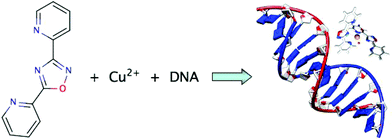Synthesis, characterization, cellular uptake and interaction with native DNA of a bis(pyridyl)-1,2,4-oxadiazole copper(ii) complex†‡
Abstract
The

* Corresponding authors
a
Dipartimento di Chimica Inorganica e Analitica “Stanislao Cannizzaro”, Università degli Studi di Palermo, Viale delle Scienze, Parco d'Orleans II, Edificio 17, Palermo, Italy
E-mail:
gbarone@unipa.it
Fax: +39 091 427584
b
Dipartimento di Chimica Organica “E. Paternò”, Università degli Studi di Palermo, Viale delle Scienze, Parco d'Orleans II, Edificio 17, Palermo, Italy
E-mail:
pace@unipa.it
Fax: +39 091 596825
c Dipartimento di Chimica, Università di Siena, Via Aldo Moro, Siena, Italy
d Dipartimento di Scienze Biochimiche, Università degli Studi di Palermo, Policlinico Universitario, Via del Vespro 129, Palermo, Italy
The

 Please wait while we load your content...
Something went wrong. Try again?
Please wait while we load your content...
Something went wrong. Try again?
A. Terenzi, G. Barone, A. Palumbo Piccionello, G. Giorgi, A. Guarcello, P. Portanova, G. Calvaruso, S. Buscemi, N. Vivona and A. Pace, Dalton Trans., 2010, 39, 9140 DOI: 10.1039/C0DT00266F
To request permission to reproduce material from this article, please go to the Copyright Clearance Center request page.
If you are an author contributing to an RSC publication, you do not need to request permission provided correct acknowledgement is given.
If you are the author of this article, you do not need to request permission to reproduce figures and diagrams provided correct acknowledgement is given. If you want to reproduce the whole article in a third-party publication (excluding your thesis/dissertation for which permission is not required) please go to the Copyright Clearance Center request page.
Read more about how to correctly acknowledge RSC content.
 Fetching data from CrossRef.
Fetching data from CrossRef.
This may take some time to load.
Loading related content
